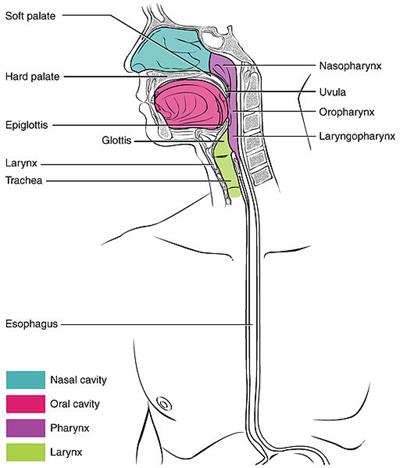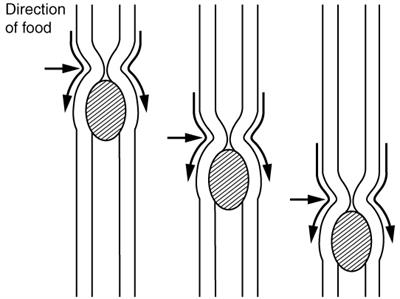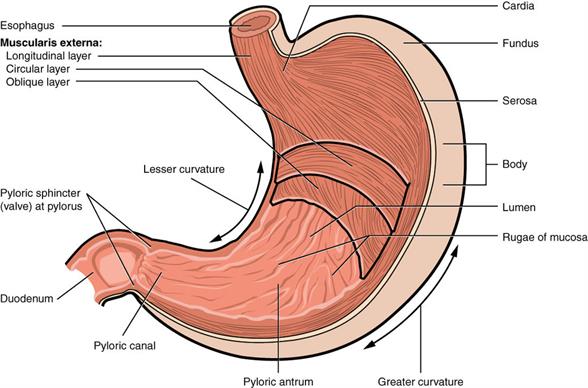PDF chapter test TRY NOW
Pharynx
The pharynx is divided into three parts:
a. Nasopharynx - Lies behind the nasal cavities and above the soft palate. The auditory tube or eustachian tube connects the nasopharynx with the ear.
b. Oropharynx - Lies behind the buccal cavity.
c. Laryngopharynx - Inferior part of the pharynx. It is a common passage for food and air.

Parts of pharynx
Oesophagus
Oesophagus also called the food pipe, is about \(25\) \(cm\) long. It is a highly muscular tube that is lined by stratified squamous epithelium. The oesophagus opening is called the gullet. It lies behind the trachea and the heart. It is composed of three parts:
a. Cervical part
b. Thoracic part
c. Abdominal part
It passes through the diaphragm and opens into the stomach. The oesophagus transfers the food from the pharynx to the stomach by peristaltic movements.
Peristaltic movements are the contractions and expansion of the oesophageal smooth muscles to push the bolus along the gut.

Peristalsis
Stomach
It is a J - shaped sac or organ, which is the widest organ of the alimentary canal. The longitudinal folds of the stomach are formed of the mucous membrane. The stomach contains peptic or chief cells, oxyntic cells and mucous cells.
The stomach has four parts:
a. Cardiac part - Present near the heart and thus called cardiac part. The gastroesophageal sphincter lies in the opening between the esophagus and stomach.
b. Fundus - Fundus is commonly filled with air or gas.
c. Body - The body is the main part of the stomach.
d. Pyloric part - The posterior part of the stomach, which is divided into the pyloric antrum and pyloric canal. Pyloric canal opens into the duodenum.
The pyloric sphincter is a valve that guards the opening between the stomach and the duodenum, which functions to permit the partially digested food (bolus) to enter the duodenum and leave the stomach.

Parts of the stomach
Functions of the stomach
a. Stores the food for \(3 - 4 hrs\). Churns, disintegrates the food and mixes the food with the gastric juice.
b. Partial digestion of proteins and fats takes place.
c. Secretes enzymes - pepsinogen, prorenin, gastric lipase and gastric amylase.
d. Secretes hydrochloric acid (\(HCl\)), making the medium inside the stomach acidic. An acidic medium is required for gastric enzymes to work.
e. Pepsin secreted inside the stomach partially digests the protein.
f. Secretes mucus by the stomach walls which protects the inner lining of the stomach from getting damaged from \(HCl\).
g. Secretes hormone gastrin.
h. The stomach's walls absorb alcohol, aspirin, small amounts of sugar, and water.
Reference:
https://commons.wikimedia.org/wiki/File:2411_Pharynx.jpg
https://upload.wikimedia.org/wikipedia/commons/e/ef/2404_PeristalsisN.jpg
https://upload.wikimedia.org/wikipedia/commons/thumb/6/6a/2414_Stomach.jpg/1024px-2414_Stomach.jpg
